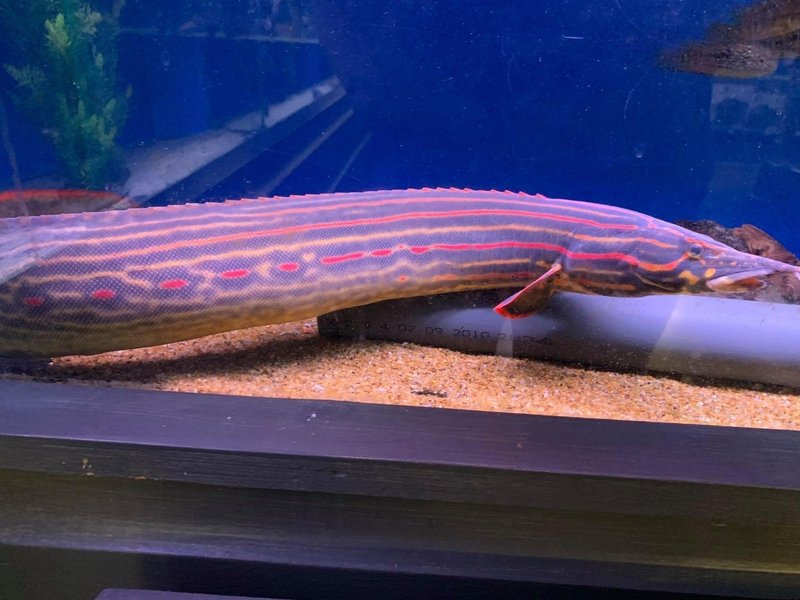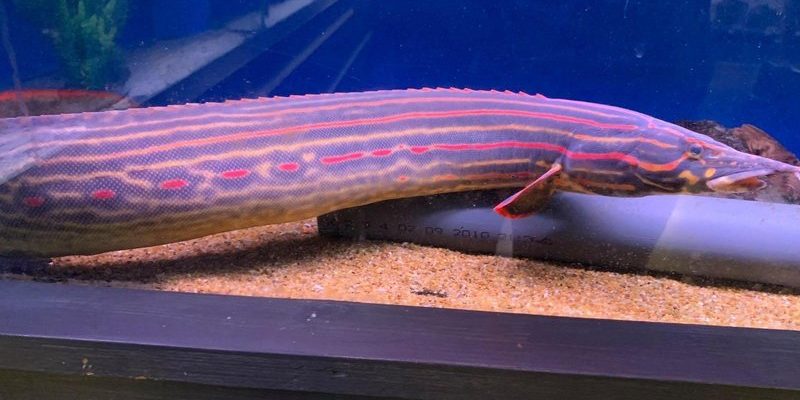
If you’ve ever seen a Fire Eel, you probably couldn’t help but be captivated by its vibrant colors and unique appearance. Imagine a creature that seems to glow in the water, with a shimmering body that combines hues of gold, orange, and red. This remarkable fish isn’t just beautiful; it’s also fascinating in terms of its behavior and habitat. Whether you’re an aquarium enthusiast or just curious about aquatic life, there’s so much to uncover about this stunning species.
The Fire Eel, which is not actually an eel but rather a type of freshwater fish called a Mastacembelus erythrotaenia, can be quite an intriguing addition to any tank. Known for their long, slender bodies and striking patterns, these fish have made a name for themselves in the aquarium hobbyist community. But there’s more than meets the eye with these creatures—learning about their needs, habitat, and behaviors can help ensure they thrive in captivity.
Physical Characteristics
The Fire Eel can grow impressively large, often reaching lengths of up to 30 inches when fully grown. Its elongated body is covered in smooth scales, which reflect light beautifully when they swim through the water. The unique coloration of the Fire Eel can vary quite a bit, but it typically showcases a palette of rich oranges and reds, which can appear even more vibrant under the right lighting conditions. This striking appearance is one of the reasons why they are a sought-after fish for aquarists.
One of the standout features of the Fire Eel is its head, which has a flattened shape that gives it a distinct look. Instead of the typical eel-like head you might expect, the Fire Eel has a more rounded appearance with large, expressive eyes that contribute to its personality. The fins are also quite remarkable, with long dorsal and anal fins that extend along its body. These fins help the Fire Eel maneuver through its environment with grace, making them agile swimmers despite their size.
Habitat and Distribution
Fire Eels are native to the waterways of Southeast Asia, particularly the regions around the Mekong River and the freshwater swamps of Thailand and Myanmar. These environments are characterized by slow-moving or stagnant waters, which provide the perfect habitat for Fire Eels to thrive. They often hide among rocks, plants, and mud, which offers them protection from potential predators. This hiding behavior is crucial for their survival, especially during the day when they prefer to rest.
In the wild, the Fire Eel tends to be a bit of a nocturnal creature, becoming more active during the night when it hunts for food. Its natural diet consists mainly of worms, crustaceans, and small fish, which it hunts in the murky waters where it resides. If you think about it, this nighttime lifestyle is not unlike that of many other creatures that prefer the cover of darkness—giving them a strategic advantage for feeding.
| Size: | Up to 30 inches |
| Habitat: | Freshwater swamps and rivers in Southeast Asia |
| Diet: | Worms, crustaceans, and small fish |
| Lifespan: | 10–15 years in captivity |
| Temperament: | Generally peaceful, but can be territorial |
Caring for Fire Eels in Captivity
Keeping a Fire Eel can be a rewarding experience, but it’s essential to understand their specific care requirements to ensure they live a healthy and happy life. First off, the tank size is crucial. Because these fish can grow quite large, a minimum of 75 gallons is recommended for a single Fire Eel. This gives them plenty of space to swim and explore. Additionally, it’s vital to set up the aquarium with plenty of hiding spots—think caves, rocks, and dense plants—to mimic their natural habitat.
Water quality is another important aspect of Fire Eel care. These fish thrive in warm water temperatures ranging from 75°F to 82°F, and they prefer soft, slightly acidic to neutral pH levels. Investing in a good filtration system and performing regular water changes will help maintain the necessary water quality. Remember, Fire Eels are sensitive to sudden changes in their environment, so gradual adjustments are key.
Feeding a Fire Eel
Feeding your Fire Eel a balanced diet is essential for their health. In captivity, they can adapt to various foods, but live foods tend to be the most engaging for them. You can offer them earthworms, bloodworms, or brine shrimp as a staple diet. Additionally, sinking pellets and high-quality frozen foods can supplement their meals. It’s important to observe their feeding habits to ensure they are eating adequately, as sometimes shyer individuals might miss out on meals if they feel threatened.
When it comes to feeding frequency, younger Fire Eels might require daily feeding, while adults can be fed every other day. Just like us, a varied diet is beneficial! Mixing up their food types not only keeps things interesting but also ensures they get all the nutrients they need to thrive. You might find yourself enjoying the feeding routine as these charming fish become more comfortable and confident around you.
Behavior and Temperament
The Fire Eel has a fascinating and sometimes complex personality. In general, they are peaceful fish that can coexist with a variety of tank mates, provided those mates are not small enough to be seen as prey. However, they can show territorial behavior, especially during breeding season or when they feel their space is invaded. This can sometimes lead to squabbles, so monitoring their interactions is essential.
One unique behavior to note is their tendency to dig. Fire Eels love to burrow into the substrate, which is a natural instinct that helps them feel secure. If you observe your Fire Eel nestled into the substrate or hiding among decorations, it’s usually a sign that they are comfortable in their environment. Providing them with adequate substrate thickness will help facilitate this natural behavior and ensure they remain happy and stress-free.
Breeding Fire Eels
Breeding Fire Eels in captivity can be quite challenging, largely due to their specific requirements and behaviors during mating. In the wild, they often spawn during the rainy season, which leads to increased water levels and changes in water chemistry. In an aquarium setting, replicating these conditions can be tough, but some aquarists have successfully bred them through careful management of water parameters and diet.
If you’re interested in breeding Fire Eels, you’ll need to create a breeding setup that provides ample space and appropriate hiding spots. Watch for signs of courtship, which may include increased activity and displays of dominance. Once the female lays her eggs, the male will fertilize them, and it’s best to remove him after to prevent him from eating the eggs or fry. This is a delicate process, but it can be quite rewarding to witness the entire cycle of life.
Conservation Status
Currently, the Fire Eel is not listed as an endangered species, but habitat destruction and pollution in their native environments pose threats to their populations. As more people become interested in aquaculture to alleviate pressure on wild populations, breeding Fire Eels for the aquarium trade has become more common. Supporting ethical practices and purchasing captive-bred specimens instead of wild-caught fish helps protect their natural habitats.
In addition, being informed about responsible fishkeeping is crucial for anyone interested in having Fire Eels as pets. This means ensuring your aquarium isn’t overstocked and that you’re providing a suitable environment for them to thrive. By adopting sustainable practices, you can contribute to the conservation of this beautiful species and others like it.
FAQ
What is the lifespan of a Fire Eel?
In captivity, Fire Eels can live between 10 to 15 years if provided with the right care. Their lifespan can be affected by factors such as water quality, diet, and tank size. Ensuring a stable and healthy environment is key to helping them reach their full potential.
Are Fire Eels good pets for beginners?
Fire Eels can be a bit challenging for absolute beginners due to their size and specific care requirements. They need a large tank and well-maintained water conditions. However, if you’re committed to learning and creating an ideal environment, they can be a rewarding addition to your aquarium.
Do Fire Eels need a heater in their tank?
Yes, a heater is recommended for a Fire Eel’s tank. They prefer warm water temperatures between 75°F to 82°F, so keeping the water consistently warm is crucial for their health and well-being.
Can Fire Eels live with other fish?
Fire Eels can be compatible with various tank mates, but it’s essential to choose larger, peaceful species. Smaller fish may be seen as food, and aggressive species can stress them out. It’s best to monitor interactions when introducing new tank mates.
How often should I feed my Fire Eel?
Younger Fire Eels should be fed daily, while adults can be fed every other day. Offering a variety of foods, including live and frozen options, is essential for maintaining a balanced diet and keeping them engaged during feeding times.
What substrate is best for a Fire Eel tank?
A soft, sandy substrate is ideal for a Fire Eel’s tank. It allows them to dig and burrow, mimicking their natural behavior. Avoid sharp substrates that could injure their delicate bodies.
Do Fire Eels require special lighting?
Fire Eels do not require special lighting, but it’s best to provide a lighting setup that simulates natural daylight cycles. Ensure that the tank has areas of shade created by plants or decorations, as they enjoy hiding and resting.
Can Fire Eels breed in captivity?
Breeding Fire Eels in captivity is challenging but possible. It requires replicating their natural spawning conditions, such as changes in water quality and diet. Preparing a suitable breeding tank and monitoring behavior can improve your chances of success.
What diseases should I watch for in Fire Eels?
Common diseases in Fire Eels include ich, fin rot, and bacterial infections. Maintaining good water quality and a clean tank can help prevent these issues. Always keep an eye on your fish for any signs of illness and act quickly if you notice anything unusual.
Are Fire Eels social fish?
Fire Eels can be social to a degree, especially when kept with compatible tank mates. However, they may exhibit territorial behavior, so it’s essential to provide ample hiding spots and space in the tank to keep them comfortable.
What is the best temperature range for Fire Eels?
The ideal temperature range for Fire Eels is between 75°F to 82°F. Keeping the water within this range helps to ensure their health and vitality. Using a reliable aquarium heater will help maintain a stable temperature.

